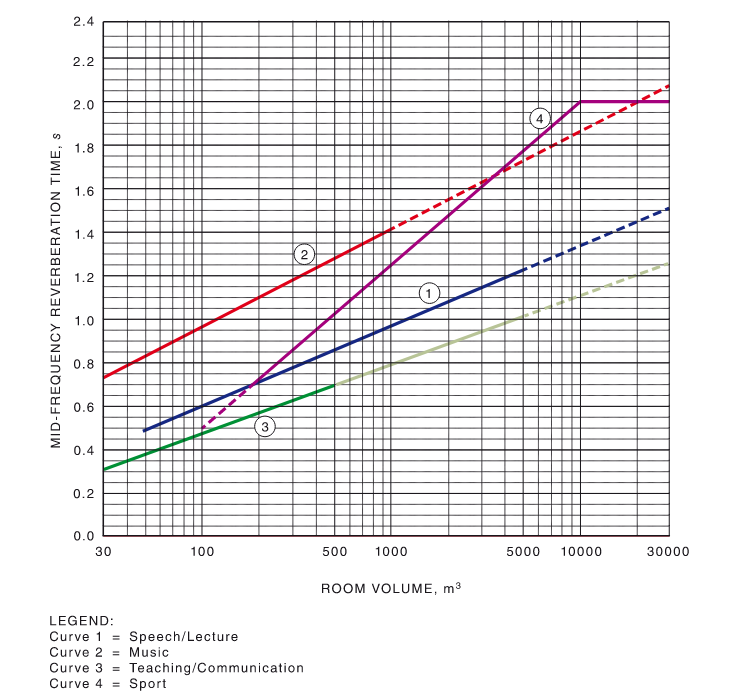Sound and Acoustics
Spoken word is central to the delivery of learning and teaching activities. Additionally hyflex and distributed modalities are forming an essential part of the delivery model. Sound sources within the room include (but are not limited to)
- Instructor/Lecturer voice lift – Lectern/boundary microphones, lapel microphones, handheld microphones
- Student/Participant voice lift – table microphones, ceiling microphones, handheld microphones, wireless boundary microphones
- Computer/multimedia audio – extracted from HDMI video sources within the room
- Auxillary audio – input via RCA, 3.5mm jack, XLR or Bluetooth
- Conferencing/Remote participant audio – extracted from HDMI video source or from a conferencing codec
- Event Audio – input and output via a dedicated Dante/AES67 interface
Acoustic Standards
- AS/NZS2107:2016 Acoustics – Recommended design sound levels and reverberation times for building interiors
- AS/NZS ISO 717.1:2004 – Rating of sound insulation in building and of building elements.
- IEC60268.16 – Sound System Equipment part 16: Objective rating of speech intelligibility by speech transmission index
Reverberation and Reflections
Rooms should be optimised to reduce late-arriving sound. Early reflections (< 30ms) may assist in understanding of speech and with coverage, however reflections later than 30ms are often perceived as echo and will detract from the ability to recognise and understand speech.
For critical listening spaces such as performance spaces and tiered lecture theatres the geometry of the space plays a critical role in the acoustic performance of the space. Early input from an acoustic consultant that specialises in performance spaces should be sought in the preliminary design phases of the project.
Generally, all spaces shall be designed such that their reverberation time is less than or equal to the reverberation times illustrated in Figure A1 of AS/NZS2107:2016 – provided below for reference.

Background Noise
Controlling both internal and external noise within learning and meeting spaces is essential. The following sources may be present and can increase background noise levels to a point that intelligibility is impacted:
- Mechanical and hydraulic services (air conditioning, plumbing, fire)
- Equipment racks, AV equipment and computers
- Structure-borne noise and vibrations from other locations in the building
- Noise ingress from adjacent spaces, corridors, road traffic or outdoor activities (including weather, sports and events)
Rooms and buildings can be designed to reduce the ingress of noise into learning spaces – and advise should be sought from an acoustic consultant to ensure that correct mitigation strategies form part of the design.
Occupation of spaces should be assumed to be 100% - therefore it should be assumed that any surrounding space is occupied – and generating noise – when undertaking an acoustic evaluation.
Background noise within standard spaces shall have an LAeq of < 35dB(A), with computer and teaching laboratories allowing for a background noise of up to 45dB(A). Teaching laboratories with fume cabinets and other high-volume air movement devices shall be measured with the cabinets off.
Allowance for close-mic’ing of the lecturer via headset is strongly advised in any space with > 35db(A).
Signal to Noise Ratio (SNR)
The signal (amplified or unamplified speech) to noise (all other sound) ratios at listening positions should be better than 25dB to optimise intelligibility.
In certain spaces where there may be high background noise this may not be practical (eg. 75dB background noise + 25dB of signal would be 100dB overall, too loud to be comfortable for the users of the space). In these situations, alternative methods such as closed-ear hearing augmentation may be considered.
Speech Intelligibility
STI is the objective measure to predict intelligibility of speech transmitted from talker to listener by a transmission channel.
The STI scale ranges from 0 (unintelligible) to 1.0 (perfect).
Curtin has a design target of >0.80 (excellent).
As proper testing of STI can be onerous, STIPA testing may be used to validate design.
Speech Privacy
Meeting rooms in particular should be constructed with a mind to acoustic privacy. An STC of 50 is the minimum acceptable design criteria for a new build meeting room or conference room. An STC of 55 should be the goal.
Senior staff offices with conferencing should be engineered to at least an STC of 45.
Classrooms should be engineered to an STC of at least 45
Consulation rooms within health facilities should be engeeringed to an STC of at least 55.
Electroacoustic Modelling
In certain noise-critical spaces, a detailed electroacoustic model may be required to predict coverage (SPL and uniformity) as well as STI and reverberation.
These models may be prepared in an acoustic simulation program such as AFMG’s EASE.
Modelling is a tool to validate design. First principals calculations and designer experience must be used in the first instance to inform the room’s designs.
As this process is highly labour intensive, Curtin does not require a detailed model for all spaces, and in many instances may only request that a basic coverage map is undertaken using a tool such as EASE Focus or EASE Address, to validate that the number and type of speakers within the plan is suitable.
For difficult acoustic spaces, DTS may request full modelling prior to design sign off to ensure that the audio system will meet the minimum performance requirements. This requirement will be advised during the design phase of the project.